Intel’s Sandy Bridge i7-2820QM: Upheaval in the Mobile Landscape
by Jarred Walton on January 3, 2011 12:00 AM EST- Posted in
- Laptops
- Intel
- Sandy Bridge
- Compal
Mobile Sandy Bridge Gaming Performance
Sandy Bridge is clearly a faster CPU than the preceding Arrandale and Clarksfield offerings—that’s no surprise. The integrated graphics are also faster, but being faster than old Intel’s HD Graphics isn’t saying a whole lot. Then again, AMD’s old HD 4250 IGP isn’t much better and is long overdue for a replacement. We’ll talk about that in a second, but first here are the standard gaming performance results at our “Low” defaults. “Medium” detail will be on the next page.
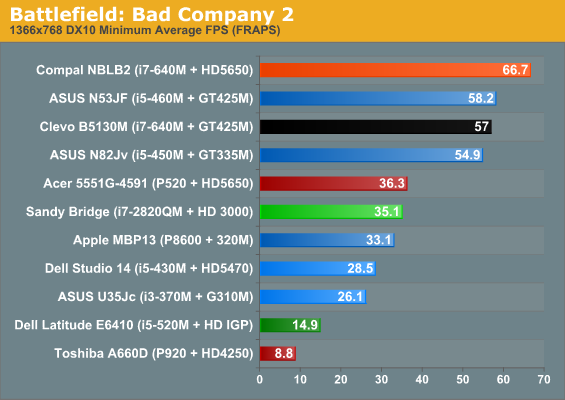
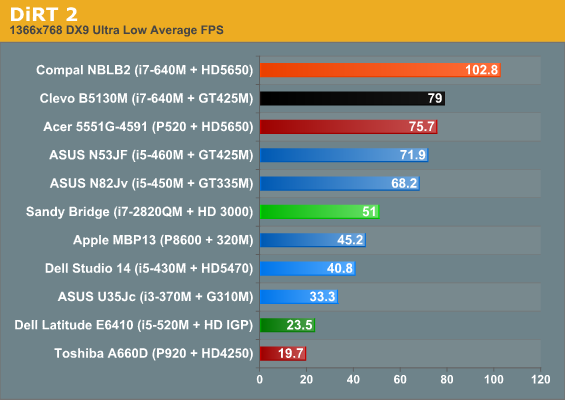
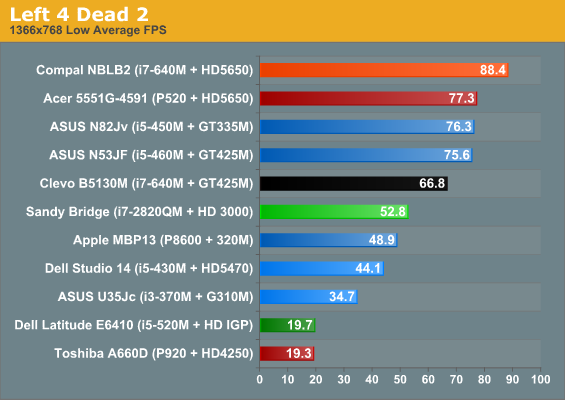
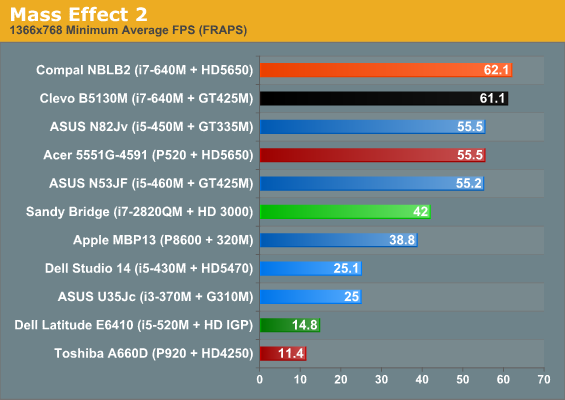
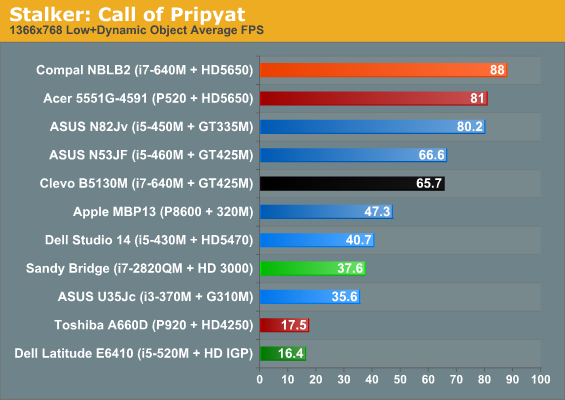
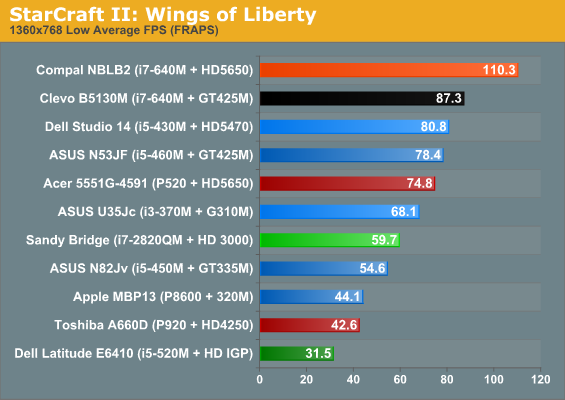

Let’s start by talking about compatibility problems with the Intel IGP: there were none! I know it’s been fashionable over the years to bash on Intel for horrible drivers that can’t run games, and the previous IGPs certainly still fall into that “too slow” category, but of our standard six test titles both Sandy Bridge and Arrandale IGPs loaded and ran every single title. That makes talk of performance meaningful, and that’s the bigger story by far.
Again, Sandy Bridge delivers playable performance in every single title at 768p and “Low” detail settings. What’s more, it actually surpasses the GeForce 320M in Apple’s MacBook Pro 13 in five out of six games (the exception being STALKER). Similarly, it beats the entry-level Radeon Mobility 5470 in four out of six games (STALKER and StarCraft II being the exceptions) and the G 310M in five out of six (SC2 came out ahead on the 310M).
All told, Intel’s HD Graphics 3000 checks in an average of 6% faster than HD 5470, 8% faster than GeForce 320M, 25% faster than G 310M, and a whopping 130% faster than both the previous generation HD Graphics and AMD’s HD 4250 (which are essentially tied in overall performance across the selected titles). Which is not to say it wins everywhere; even with a much slower Turion II P520 Processor, the HD 5650 still leads HD 3000 by 44%; shift the same GPU to an i7-640M to remove the CPU bottleneck and the 5650 beats HD 3000 by 130%. NVIDIA’s GeForce GT 425M also leads the 3000 by 46% on average, so discrete GPUs are by no means in danger of being replaced.
We didn't have time to do serious image quality comparisons, but subjectively there did appear to be a few games where the Intel IGP wasn't rendering at the same level of detail, but it's hard to say when you're not running at the native LCD resolution; we'll get into problems in a moment, but other than those mentioned we didn't have any serious complaints. After all, being able to run a game at all is the first consideration; making it look good is merely the icing on the cake.










66 Comments
View All Comments
JarredWalton - Monday, January 3, 2011 - link
All of the mobile chips list AES/TXT/vPRO support, unlike the desktop chips. They also all support Quick Sync and have 12 EUs.DesktopMan - Monday, January 3, 2011 - link
What about virtualization? Not sure why you are mentioning vPro, the requirement for vPro is usually the chipset, in this case QM67.JarredWalton - Monday, January 3, 2011 - link
They don't specifically break out VT-d and VT-x on the mobile products; all the slides state is that the mobile products support virtualization. On the desktop slide, they have a line saying "vPro/TXT/VT-d/SIPP" but on mobile slides the line says "AES/TXT/vPro". There's a second line for both desktops and mobile chips that just says "Intel Virtualization Technology" but it's not too useful since it just says "Yes" on every single Sandy Bridge CPU listed. :-\Hrel - Monday, January 3, 2011 - link
finally gaming on IG. Sooo, when do new Nvidia Gpu's come out for laptops?JarredWalton - Monday, January 3, 2011 - link
Check back on Jan 6. :-pmobomonster - Monday, January 3, 2011 - link
AMD is toast. Those are blistering performance numbers that even I did not expect. Incredible that it manages near 30 fps in several games at medium detail settings.The lower power dual core Sandy Bridge models will really put the squeeze on AMD. Even a regular 2520M will give AMD's Brazos a lot of trouble.
tipoo - Monday, January 3, 2011 - link
Bah, AMD has been toast for years now, if they really were, they would be buttered and eaten already.yes, horrible metaphor is horrible.
Kangal - Monday, January 3, 2011 - link
I'm a tech enthusiast especially in the portable device scene, and I always nit-pick things.Which is the reason why I own the Acer 4810TG.
The Core i7 640-UM would be my favourite processor, until I saw this.
The successor, 2657M, seems to have (theoretical) performance improvement of 19% and battery saving of 6%, which is very amazing.
From pure guestimation, this is ~200% (or slightly more) performance of the SU7300 at the same battery life. Whoa!
This would mean new ultra-portable devices (less than 14" and over 6 hours battery life).
If this gets partnered with the ATi 5650 (or its successor), this will bring serious gaming potential to ultra-portable devices *drools*
------
BUT, I wish they could add another chip on that (ULV) list.
The exact same thing as the i7 2657M but tossing the dual-core setup for a single core, if it meant they could increase the down the battery life by 70%. (Name it the 1357M?)
I mean, how about real 10 hours battery life (6 cell) on something about as fast as the SU7300 ??
Something like that (Core i7 1357M?) could make Windows7 tablets a more viable option.
davepermen - Monday, January 3, 2011 - link
I'd prefer a dualcore with 1ghz, or even 800mhz. as it could still clock to 2ghz or so, it would be fast when needed, but very battery saving else.if intel would go down further, it would most likely by now kill atom in the netbook and tablet area. and in the phone area, atom isn't there yet.
personally, i hate atom for being in the way. ultralow core i1 would be AWESOME.
JarredWalton - Monday, January 3, 2011 - link
SpeedStep lets all the SNB processors (mobile versions at least) run at 800MHz when they're not doing anything else. So you've already got what you're asking for, more or less.